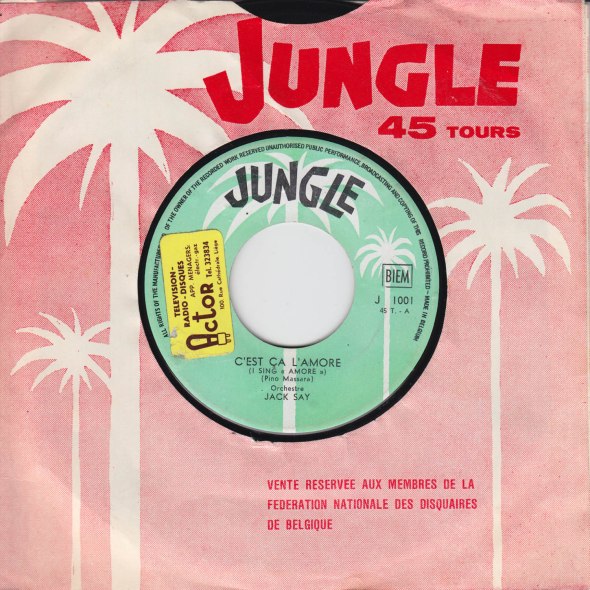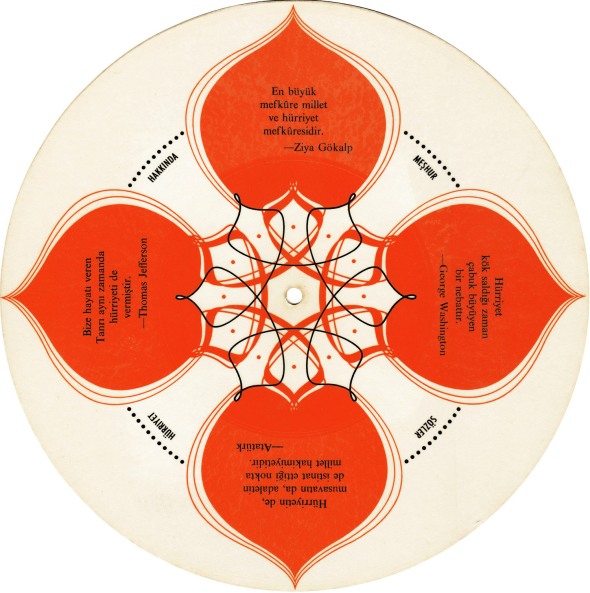Jazz vs. Rock and Roll
Posted: September 12, 2018 Filed under: 50s, Comedy, Jazz Records, Rock´n´Roll Records, USA 3 Comments
 My baby and I, had a fight last night/ She said I´m wrong, but I know I´m right/
My baby and I, had a fight last night/ She said I´m wrong, but I know I´m right/
Now, I love that gal – heart and soul/ But I dig Jazz! … and she loves Rock´n´Roll!
Found this crazy 45 in the cheapo bin of a local second-hand record store last week, for one measly Euro. No idea how it ended up there, but it sure is a killer.
Issued by the Jaro label in 1959, at the hight of the Beatnik-craze, this was Woody Byrd´s sole 45. Jaro was a subsidiary of Top Rank International. This seems to be the label´s first release. Both sides were also issued on Top Rank in New Zealand. Jazz vs. Rock and Roll would have fit perfectly on the Welcome to the Beat Generation – comp that came out in the late 90s. Despite its cool combination of jive talk, swingin´ jazz music and rock´n´roll guitars, the song has never been re-released. At least I couldn´t find it. Maybe it´s too much of a real novelty break-in record, to be of interest to rock´n´roll fans. Much less jazz fans.
Or maybe it´s just too silly…
WOODY BYRD, Jazz vs. Rock´n´Roll, 1959
The title of the flip is a bit misleading. Chop Sticks Cha Cha Cha is a latin-tinged Rhythm & Blues tune with a cool saxophone solo…
WOODY BYRD, Chop Sticks Cha Cha Cha, 1959
My baby and I, had a fight last night/ She said I´m wrong, but I know I´m right/
Now, I love that gal – heart and soul/ But I dig Jazz!/ …/ and she loves Rock´n´Roll!/…/
She said I´m square and just don´t swing/ I said get hip baby and dig my scene/
Oh me oh my what a rigamarole/ cause I love Jazz!/ …/ and she digs Rock´n´Roll/…/
It was a wild scene all the way/ …/ two radios were blasting night and day/ …
I´d be coolin´Jazz on my Christmas set/ …/ Then she tuned in some crazy quartet!/ …/
(Turn it off! Turn it off!)
We were so confused, we didn´t know what to do/ So we just decided, that they both would do/
And now we get our kicks today,/ whenever we hear that cool cat say:/
(„A one, and a two and a…“)
Bei uns in der kleinen Bar
Posted: April 5, 2018 Filed under: 50s, Cartoon Sleeves, Germany, Instrumental Records Leave a comment


 I´ve loved the drawing style of Hans Jürgen Press since I was a child, so I recognized it immediately when I saw the album cover of this 10″. The clear, slightly broken lines, the big noses and the light-hearted humor are typical for this outstanding German artist. Probably because it was not directed towards children, the design is not as overcrowded with detail as his usual work. There is a well hidden small signature in the far upper right corner. Just as well hidden as the clues that Press was known for placing in his picture puzzles in The Adventures Of The Black Hand Gang.
I´ve loved the drawing style of Hans Jürgen Press since I was a child, so I recognized it immediately when I saw the album cover of this 10″. The clear, slightly broken lines, the big noses and the light-hearted humor are typical for this outstanding German artist. Probably because it was not directed towards children, the design is not as overcrowded with detail as his usual work. There is a well hidden small signature in the far upper right corner. Just as well hidden as the clues that Press was known for placing in his picture puzzles in The Adventures Of The Black Hand Gang.
The album is a showcase of the Philips label instrumental pop catalog, ca. 1955, in combination with a “bar” concept: added background noise, chatter, clapping, glasses clanking, interrupted by the Polychord organ of Conni Amberg. It´s like a radio play without the speakers – you hear only the background sounds.
My favorite track is a medley of Margie, Nola and Dardanella by Svend Asmussen and his orchestra. Danish jazz violinist Svend Asmussen died last year at the age of 100. In the 50s, Asmussen was influenced by the violinist Stuff Smith, but this medley sounds more like the guitar wizardry of Les Paul…
BEI UNS IN DER KLEINEN BAR, Margie-Nola-Dardanella Medley
I like this version with the added clapping better than the original version. You can listen and compare it here.
Initially, I didn´t want to post the whole album, because I thought it was boring. Then, after listened to it for a while, I found it to be strangely soothing. I guess, I´m into elevator music now…
BEI UNS IN DER KLEINEN BAR, Seite 1
BEI UNS IN DER KLEINEN BAR, Seite 2
Kenn´ Se den?
Posted: March 25, 2018 Filed under: 50s, Berlin Records, Cartoon Sleeves, Comedy, Flexible Records, Promotional Records 1 Comment
 Two weeks ago, I found this record at a Berlin record convention. This promotional flexi-disc for the Berlin tobacco company of Otto Boenicke fits the framework of Berlin Beatet Bestes perfectly. The front side of the record was illustrated by Helmut Nickel. Nickel, an outstanding stylist in the German post-war adventure comic genre, was known for his instantly recognizable black and white pen work. This gouache style illustration shows, he was very good with color, too.
Two weeks ago, I found this record at a Berlin record convention. This promotional flexi-disc for the Berlin tobacco company of Otto Boenicke fits the framework of Berlin Beatet Bestes perfectly. The front side of the record was illustrated by Helmut Nickel. Nickel, an outstanding stylist in the German post-war adventure comic genre, was known for his instantly recognizable black and white pen work. This gouache style illustration shows, he was very good with color, too.
Born March 24, 1924 in Dresden, Helmut Nickel fought in WW II, was a prisoner of war for three years and left East-Germany for West-Berlin in 1948. To finance University, Nickel started illustrating various comics series in 1952. From 1952 to 1964 he worked on a whole series of comics, such as Robinson, Hot Jerry, Titanus, Die 3 Musketiere, Der Graf von Monte Christo and Peter’s seltsame Reisen.
( Robinson No. 84, page 11, 1958. From the collection of Hansi Kiefersauer.)
Informed by his studies, Nickel´s comics were educational, at a time when comics were still regarded as trash that was subverting the children. After finishing University in 1959, Nickel worked in a Berlin museum and then applied for a job at the New York Metropolitan Museum as a curator of the historical weapons collection. He stayed there until his retirement in 1989. Today he lives in Florida.
In 2011 Helmut Nickel was honored with a lifetime achievement award at the Munich Comic Festival. Yesterday, Helmut Nickel turned 94.
The Helmut Nickel-side of this flexi is a tongue-in-cheek narration admiring the beautiful brown body of a Boenicke cigar…
Boenicke-Rumba (The song doesn´t have a title. I just called it that.)
Like many flexi discs that I´ve posted over the years this was also published by the Phonocolor company of Berlin-Lichterfelde. Phonocolor also issued the Okay Exquisit, Rondo and Topas labels.
While the Rumba-side runs at 45 rpm, the side with the cigar smoking middle-aged gentlemen runs at 33 rpm. Compared to the comissioned front, this looks like a stock illustration. The male and female narrators sound like Berlin cabaret Die Stachelschweine. Five jokes interrupted by some boogie woogie piano. Kenn´ Se den? Have you heard this one? …
BLUEJEAN-JENNY, Rumpelstilzchen-Boogie, 1958
Posted: October 27, 2017 Filed under: 50s, Berlin Records, Flexible Records, Germany, Rock´n´Roll Records Leave a comment
 Rumpelstilzchen-Boogie is a German cover version of Lou Monte´s Someone Else Is Taking You Home. The German lyrics, written by Klaus Doll and Nicolaus Hix, are completely unrelated to the original and were probably made to fit the kiddie rock´n´roll concept.
Rumpelstilzchen-Boogie is a German cover version of Lou Monte´s Someone Else Is Taking You Home. The German lyrics, written by Klaus Doll and Nicolaus Hix, are completely unrelated to the original and were probably made to fit the kiddie rock´n´roll concept.
The Berlin ultra-budget flexi-label Rondo took over both sides from the Austrian Harmona 3-D label. Changing the pseudonym from Bluejean-Jenny to Susanne, the sides were also released in Austria by Schallplattengilde Gutenberg. Discogs and various German collector-sites accredit both releases to Susanne Adorjan, most likely because she was the only Susanne in the roster of both labels.
Rumpelstiltskin-Boogie…
BLUEJEAN-JENNY, Rumpelstilzchen-Boogie
Bluejean Cinderella was originally recorded by the The Peewees (a group of kids!) for Josie Records. German lyrics were written by Horst de Gray and Tambour, who also wrote similar teenage material in 1958 for Austrian Rocker Robert Benett (“Das freu´t mich so” (Jive after Five – Carl Perkins), “Insgeheim” (Secretly -Jimmie Rogers) and “Total Verrückt” (All Shook Up – Elvis).
BLUEJEAN-JENNY, Bluejean Cinderella
PICTURESQUE BELGIUM
Posted: October 5, 2016 Filed under: 50s, Belgium, Flexible Records 2 Comments
 Bye Bye Brussels! I´m returning to Berlin after 10 Days in the city together with the staff of Jungle World. Our “Belgium Issue” will hit the newsstands next Thursday.
Bye Bye Brussels! I´m returning to Berlin after 10 Days in the city together with the staff of Jungle World. Our “Belgium Issue” will hit the newsstands next Thursday.
Rescued a bunch of “Discocarte”- postcard records on the Marolles flea market last Sunday, shortly before I saw the rest of the box getting destroyed in the rain. Kinda sad, kinda not. Most people who´ve never seen a postcard record, seem to like the idea. Like an E-mail with a picture and an MP3 attached. Only much cooler!
Until they hear the music …
Liechtensteiner Polka
The small scanner is not in the picture, but you can see me digitizing postcard records at our house in Brussels with my portable record player:
ORCHESTRE JACK SAY, Ne Joue Pas
Posted: October 1, 2016 Filed under: 50s, Belgium Leave a comment
 On another visit to a local record shop yesterday, I found this Jungle Records 45 with great simple graphics and two different custom-made Jungle characters. How fitting, for my trip to Brussels with Jungle World!
On another visit to a local record shop yesterday, I found this Jungle Records 45 with great simple graphics and two different custom-made Jungle characters. How fitting, for my trip to Brussels with Jungle World!
And it´s another record by Jack Say ,the guy behind “Alex Trémiste et ses Meneurs”. His name is found on many Belgian budget releases. The note: “Vente reservee aux membres de la federation nationale de disquaires Belgique” – hints to a record club. No date of release given. No Jungle records label listed on discogs. This record is Jungle 1001.
Both songs were originally recorded by Dalida in 1959, so I presume this came out the same year. Two easy-listening orchestra songs that seem straight out of a Belgian 1950s movie…
ORCHESTRE JACK SAY, Ne Joue Pas
ORCHESTRE JACK SAY, C’est Ça L’Amore
CELAL İNCE, Dostluk Şarkısı (The Song of Friendship)
Posted: August 31, 2016 Filed under: 50s, Flexible Records, Political Records, Turkey Leave a comment

 In May, I bought this flexi disc at a flea market in Istanbul. It wasn´t really cheap but I didn´t mind. I was on vacation and wasn´t going to pass on a 10″ flexi disc that runs on 78RPM. When I saw it, I immediately though: “blog!” But I didn´t listen to it until I got home. Then I did a little online research.
In May, I bought this flexi disc at a flea market in Istanbul. It wasn´t really cheap but I didn´t mind. I was on vacation and wasn´t going to pass on a 10″ flexi disc that runs on 78RPM. When I saw it, I immediately though: “blog!” But I didn´t listen to it until I got home. Then I did a little online research.
The record has Cold War written all over it. At the time of its release, Turkey was a buffer zone against the Soviet empire. Tens of thousands of these propaganda flexis – recorded and pressed in the Unites States by Voice Of America – were given away for free. From the feeling and graphics of the flexi, I´d guess in the midlle of the 1950s. It takes us back to the Turkey of films like From Russia With Love (1963) and Topkapi (1964), a country in-between modernism and tradition. Only, this record is not dramatized fiction, but real.
Celal İnce, born in 1921, was the king of Turkish tango in the 40s and 50s. In the in the late 50s he immigrated to the US and has lived in Chicago ever since. İnce was in the wine business for forty years and now, aged 95, is still working as an executive wine consultant. Recently Celal İnce´s Sana Nerden Gönül Verdim was featured on „Istanbul Tango 1927-1953“, the fourth volume of the German CD compilation series Old World Tangos. The series is illustrated by none other than Berlin underground cartoonist and fine art painter Guido Sieber.
In the anthemic marching song Dostluk Şarkısı, Celal İnce praises the friendship of Turkey and the United States: “We were blood brothers in Korea/Our determination is to live free , to ensure peace in the world”. It might be full of pathos and propaganda, but I can think of worse causes. The Voice Of America probably did more damage to dictatorships by broadcasting Jazz music to Eastern Europe, than all the missiles they planted near the borders.
Whatever, it´s still only a pop song…
CELAL İNCE, Dostluk Şarkısı (The Song of Friendship)
The flip features some words by Namik Kemal on Turkish history and quotes of Franklin Roosevelt, Thomas Jefferson, George Washington, Patrick Henry, Mustafa Kemal Ataturk and Ziya Gökalp.
Hürriyet Hakkında Meşhur Sözler
Some footage of the old Yeşilköy Airport, now Istanbul Atatürk International Airport, from From Russia With Love (1963)
Footage of Istanbul street life in 1964 from Topkapi (1964):
I bought some more Akbaba magazines while I was in Istanbul. This issue from March 3rd 1962, depicting US-sailors in Turkey, seems to tie in with the above record. The bold nudity is surprising for an Islamic country. The sexism and racism are not. This type of cartooning was pretty common in the 50s and early 60s all over the world.
The cover and the next two cartoons are by Necmi Riza. The cartoon below is about the Turkish Coup d´etat that took place on May 27, 1960. The politician is waiting for the military to kick his ass.i
This one is obviously about Elisabeth Taylor standing with her lawyer in court.
This issue also has this cartoon by Yurdaer Kalayci.
Yazisiz means “Without words”.
FRED GUTMANN UND STUDIO-BAND, Ich brauche dich dazu, 1960
Posted: February 14, 2016 Filed under: 50s, Flexible Records, Rock´n´Roll Records 5 Comments Tommy Kent (born Guntram Kühbeck in 1942 in Munich) recorded the original German cover version of I Need Your Love Tonight for Polydor. It was one of the last songs Elvis cut before he left the US for Germany to serve in the Army. Incidentally, Tommy Kent started his recording career in the flexi-disc business, first recording for Hit-Ton (a postcard record label) and Roxy, a sub-label of Vox-Imago, who also pressed flexis for the Prima label.
Tommy Kent (born Guntram Kühbeck in 1942 in Munich) recorded the original German cover version of I Need Your Love Tonight for Polydor. It was one of the last songs Elvis cut before he left the US for Germany to serve in the Army. Incidentally, Tommy Kent started his recording career in the flexi-disc business, first recording for Hit-Ton (a postcard record label) and Roxy, a sub-label of Vox-Imago, who also pressed flexis for the Prima label.
Unknown Fred Gutmann´s Prima version of Tommy Kent´s Ich brauche dich dazu, comes complete with reverb vocals and imitation of Tommy´s Bavarian accent. Gutmann recorded another rocker for the Prima label, a fine cover of Billy Sanders´ Daisy du musst schlafen geh´n.
90 Pfennig – that´s what these one-sided Prima flexi-discs sold for. Supposedly a throw-away object for teenagers, 55 years later my copy still plays fine.
Plastic material can be quite durable. It´s possible. that this thin flexi might hold out another 55 years and still be around in 2070.
When nobody will remember what an MP3 was…
FRED GUTMANN UND STUDIO-BAND, Ich brauche dich dazu, 1960



































 About me:
My name is Andreas Michalke. I´m a cartoonist from Berlin, Germany and I like collecting records. Most of the records I find in thrift stores or at flea markets here in Berlin. I like a lot of music but I thought I`d focus on odd German records. Preferably with cartoon covers.
All my scans are high-resolution. If you double-click on them they will get much bigger.
About me:
My name is Andreas Michalke. I´m a cartoonist from Berlin, Germany and I like collecting records. Most of the records I find in thrift stores or at flea markets here in Berlin. I like a lot of music but I thought I`d focus on odd German records. Preferably with cartoon covers.
All my scans are high-resolution. If you double-click on them they will get much bigger.
Recent Comments